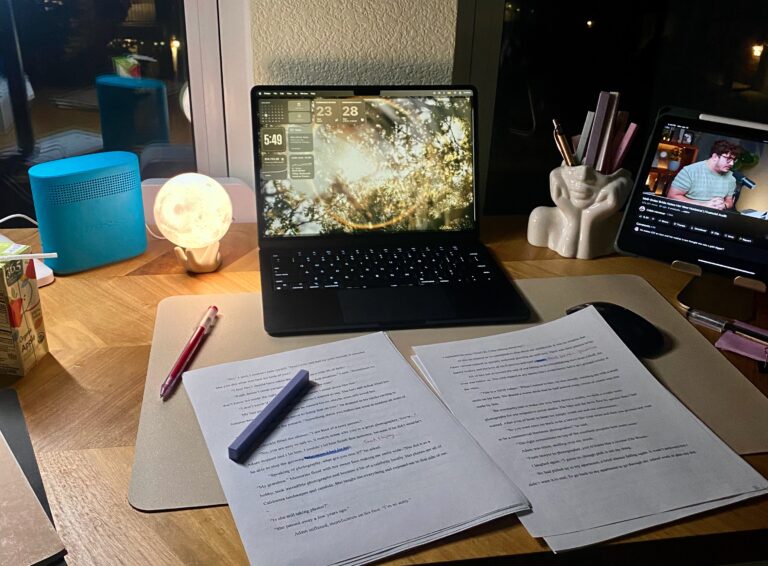By The Cheeky · December 2024

Introduction
I hate the romance novella I’m working on. It’s the third in my college hockey romance series—the final book. The series is basic, following a formula I hoped would resonate with the genre’s readers. Initially, I was excited about this last installment. Now, after three rewrites, I never thought I’d hate it so much.
Maybe I’m burnt out on the series, or maybe I’ve spent too much time on it. After some hard reflection, I realized the problem is simple (and painful): my storytelling is not where it needs to be.
Still, I can’t let it go. I owe it to my readers, my characters, and myself to finish this series properly. Here’s what went wrong—and what I’m doing to salvage my novella.
Why I Hate My Novella
The first step to fixing a problem is admitting there is one. If you feel stuck in your story, putting some space between you and the manuscript is crucial. Step away, refill your creative well, and reflect. Whether it’s reading, watching movies, or exploring a new hobby, take the time you need.
After my break and some self-reflection, I was able to pinpoint the issues:
- Flat Characters
- Low-Stakes Plot
- Flat World-Building
Novellas require a special kind of skill to pack richness and impact into a shorter word count, and I missed the mark in all three areas.
Flat Characters
I wanted to love my main characters, but I deviated so far from the original idea that I didn’t recognize them anymore. I sacrificed depth for the sake of hitting a minor trope that, in hindsight, didn’t even work.

The result? Boring characters with no spark. I couldn’t even feel the chemistry when I tried writing spicy scenes. My female main character (FMC) didn’t face any real challenges or inner turmoil, and my male main character (MMC) was bland and completely lacking in sex appeal. For a romance story, that’s a death sentence.
How to Fix It:
If you’re dealing with flat characters, re-evaluate their motivations and add relatable flaws. Perfect characters don’t resonate—Mary Sues and Gary Stus are universally disliked for a reason.
For my story, I gave my FMC more flaws to work through and added layers to my MMC. His “perfection” made him dull, so I introduced vulnerabilities and traits that made him more human. These changes should pave the way for the banter and chemistry my story desperately needs.
Low-Stakes Plot
Since my story is character-driven, the flat characters naturally led to a flat plot. By the time I got to the epilogue, I didn’t care about the story anymore and was just relieved it was over.
Good stories need stakes—problems that keep readers engaged and rooting for the characters. My novella had none. Everything worked out too perfectly, and there wasn’t enough friction to make the romance feel earned. As a romance reader myself, I hate bland, frictionless stories, so why would I write one?
How to Fix It:
If your plot feels bland, up the stakes. In romance, this could mean introducing a meddling ex or a significant misunderstanding. In other genres, it might mean killing off a beloved character or adding a time-sensitive dilemma.
For inspiration, I turned to craft books like Save the Cat! Writes a Novel and Romancing the Beat. These resources helped me tweak the stakes in ways that complemented my characters’ arcs.
Flat World-Building
The novella’s world is easy enough to describe: collegiate hockey, a prestigious school, and beautiful main characters. But it felt empty.

When I first outlined the series, I cut a lot of world-building to meet my word count goals. Looking back, this was a mistake. The setting felt like a blank white page with a few scattered details. By book three, I was bored with the world I’d created, which made it even harder to stay motivated.
How to Fix It:
The best world-building is immersive and exciting, making readers (and writers) want to linger there. If you can’t imagine being a tour guide in your story’s world, it’s time to make adjustments.
For this novella, I fleshed out the hockey environment and added specific details to make the school setting feel more alive. While I can’t rebuild the entire world in this third book, I can give it enough texture to feel engaging.
Final Thoughts

If you hate your current project, take a step back. Reflect on what’s not working, and be honest about what needs fixing.
- Refill your creative well by revisiting your favorite stories in any medium.
- Reassess your characters, plot, and world-building.
- Engage beta readers for fresh perspectives—strangers are often more honest than friends or family.
Rewriting sucks. It’s even worse when deadlines loom, but you, your characters, and your readers deserve a good story.
Let me know how your projects are going and what methods you use to fix your stories. Let’s get through this together!








